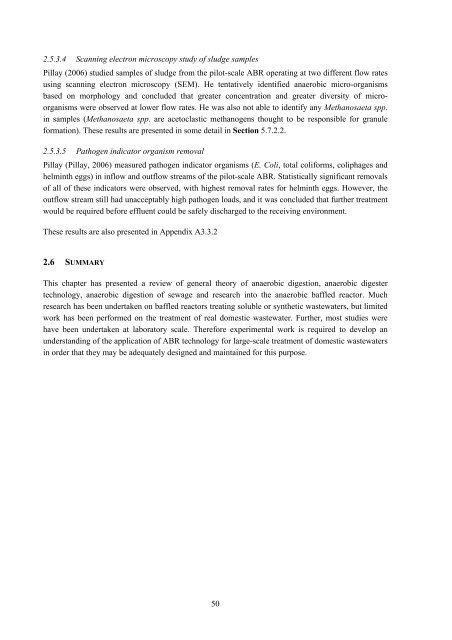analysis of a pilot-scale anaerobic baffled reactor treating domestic ...
analysis of a pilot-scale anaerobic baffled reactor treating domestic ...
analysis of a pilot-scale anaerobic baffled reactor treating domestic ...
You also want an ePaper? Increase the reach of your titles
YUMPU automatically turns print PDFs into web optimized ePapers that Google loves.
2.5.3.4 Scanning electron microscopy study <strong>of</strong> sludge samples<br />
Pillay (2006) studied samples <strong>of</strong> sludge from the <strong>pilot</strong>-<strong>scale</strong> ABR operating at two different flow rates<br />
using scanning electron microscopy (SEM). He tentatively identified <strong>anaerobic</strong> micro-organisms<br />
based on morphology and concluded that greater concentration and greater diversity <strong>of</strong> microorganisms<br />
were observed at lower flow rates. He was also not able to identify any Methanosaeta spp.<br />
in samples (Methanosaeta spp. are acetoclastic methanogens thought to be responsible for granule<br />
formation). These results are presented in some detail in Section 5.7.2.2.<br />
2.5.3.5 Pathogen indicator organism removal<br />
Pillay (Pillay, 2006) measured pathogen indicator organisms (E. Coli, total coliforms, coliphages and<br />
helminth eggs) in inflow and outflow streams <strong>of</strong> the <strong>pilot</strong>-<strong>scale</strong> ABR. Statistically significant removals<br />
<strong>of</strong> all <strong>of</strong> these indicators were observed, with highest removal rates for helminth eggs. However, the<br />
outflow stream still had unacceptably high pathogen loads, and it was concluded that further treatment<br />
would be required before effluent could be safely discharged to the receiving environment.<br />
These results are also presented in Appendix A3.3.2<br />
2.6 SUMMARY<br />
This chapter has presented a review <strong>of</strong> general theory <strong>of</strong> <strong>anaerobic</strong> digestion, <strong>anaerobic</strong> digester<br />
technology, <strong>anaerobic</strong> digestion <strong>of</strong> sewage and research into the <strong>anaerobic</strong> <strong>baffled</strong> <strong>reactor</strong>. Much<br />
research has been undertaken on <strong>baffled</strong> <strong>reactor</strong>s <strong>treating</strong> soluble or synthetic wastewaters, but limited<br />
work has been performed on the treatment <strong>of</strong> real <strong>domestic</strong> wastewater. Further, most studies were<br />
have been undertaken at laboratory <strong>scale</strong>. Therefore experimental work is required to develop an<br />
understanding <strong>of</strong> the application <strong>of</strong> ABR technology for large-<strong>scale</strong> treatment <strong>of</strong> <strong>domestic</strong> wastewaters<br />
in order that they may be adequately designed and maintained for this purpose.<br />
50
















